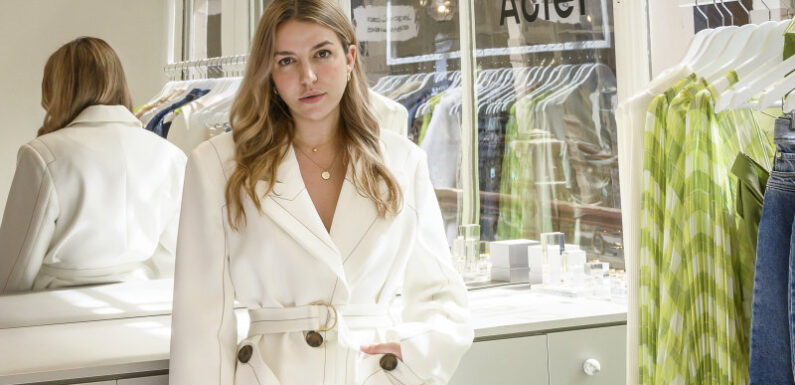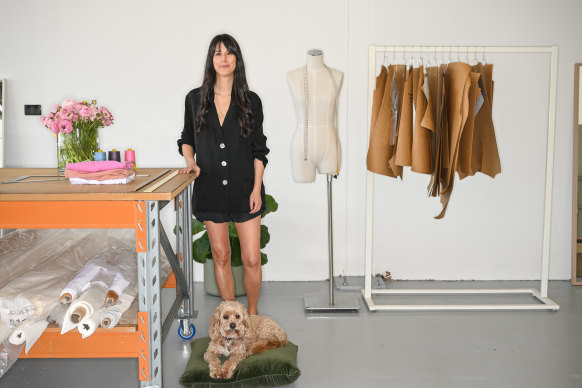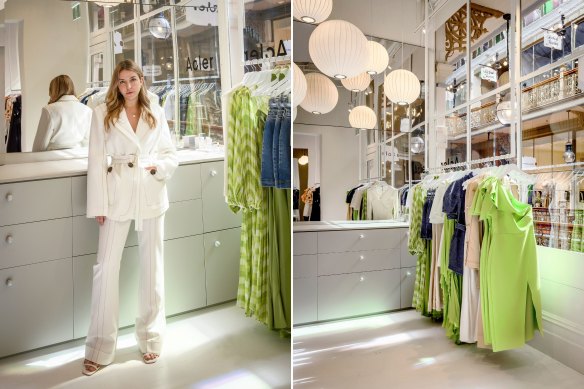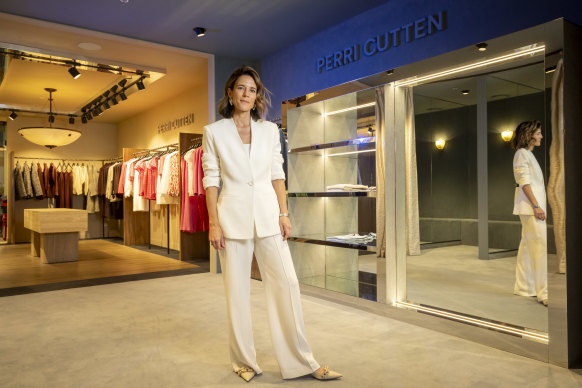
Save articles for later
Add articles to your saved list and come back to them any time.
In fashion circles, the number one question being asked around lunch tables and over flutes of champagne at flashy store launches isn’t “What’s in for summer?” but rather, “Who’s out?” As in, which fashion brands will – or won’t – survive the cost-of-living crunch?
It’s a question that could easily keep designers and founders, such as Vanessa Rochman, awake at night. But she chooses not to let it.
Dogged determination: Primness founder Vanessa Rochman and dog Roy. Credit: Eddie Jim
“I’m always [thinking about] what’s next, what can I do better? When you realise it’s the landscape, there’s some comfort in that,” says Rochman, the founder of locally made, sustainable womenswear brand Primness, which has a store in Melbourne’s Armadale and online.
As consumers juggle rising living costs on everything from housing to groceries, it’s easy to assume that few – if any – have money to spend on clothes. The latest Australian Bureau of Statistics data showed spending on clothing was up by 2 per cent for July, but the overall trend is downward.
Rochman says that after the COVID-19 spending frenzy and reopening mini-boom in late 2021, it has been a “slow burn”. She’s become used to the stream of “we’re sorry to inform you” emails signalling increased costs on everything from fabric to freight.
“As a business, you’re wearing the cost of that,” she says. “My personal strategy is to be fair [about retail price increases]. It’s not the time to be asking for so much from customers.”
Nor is it a time to be pulling back or “going vanilla”, as Rochman puts it, by only offering safe bets. For her next collection, which marks 10 years, she’s gone “all in”. It’s a similar strategy to the one she adopted in lockdown, even if customers’ spending patterns are favouring investment staples over seasonal buys.
“Quality and long-lasting things are more in fashion than ever before, and more meaningful,” she says. “[Customers] might buy one piece, but not three pieces. They still want to feel good, but the investment in themselves might be lower than what it previously was.”
Building for the future
Still, there are exceptions to that rule, especially when it comes to event dressing. Adelaide-based brand Acler has just opened its first standalone store in Sydney’s historic Strand Arcade.
Co-founder Kathryn Forth says having a physical store is a way to get closer to the brand’s customers – 40 per cent of its domestic online sales come from NSW, which was a key factor in deciding where to launch in bricks and mortar. “It’s not just another revenue stream,” Forth says of the store, but “an opportunity to showcase our collections our way”, as opposed to how a wholesaler or department store might.
Acler co-founder Kathryn Forth in the brand’s first retail store in The Strand Arcade, Sydney.
Another brand throwing everything at its future is Perri Cutten which, under new owners The Austin Group, has invested heavily in new-look stores in Sydney’s Mosman, Canberra’s Manuka, and, last week, Brighton, in bayside Melbourne.
Director Georgie Austin says it was necessary to invest heavily (how much she won’t say) in the stores to help revive the 42-year-old brand, including sourcing antique objet d’art, such as vintage bar carts under the eye of interior designer Brahman Perera. “It’s not about churn and burn – we’re trying to create these environments in store that are a bit more eclectic,” she says.
Still, Austin acknowledges that customers’ shopping habits have changed. “They’re coming in knowing what they’re wanting. The days of just browsing are possibly on pause. There’s often an event … people come to us because there’s a need – a purpose.”
‘Browsing is on pause’: Perri Cutten director Georgie Austin at the brand’s new store in Melbourne’s Brighton.Credit: Wayne Taylor
The middle-market ‘squeeze’
Retail experts agree the cocktail of rising interest rates and living costs is pushing shoppers in opposite directions. Higher income consumers, who are used to buying from designer or luxury brands, will continue to shop unhindered in this environment, and some shoppers might forgo regular purchases they used to make at more affordable brands to save up for higher-end pieces.
At the same time, households that need their dollars to stretch further are flocking to chains offering the deepest discounts.
“Those that play in the middle from a price-point perspective will continue to get squeezed,” says director of retail consultancy Retail Oasis, Trent Rigby.
National retail lead at BDO Salim Biskri says cost pressures were having an uneven impact across the sector. A rise in “quiet luxury” aesthetics has seen certain shoppers gravitate to higher-end brands for everyday pieces, providing an opportunity for retailers that cater to this trend.
“Essentially, this is luxury fashion that is high quality, sophisticated and timelessness … yet modest and understated – anti-bling or anti-showy,” he says.
But smaller and independent brands were being disproportionately impacted by broader economic pressures, Biskri says. “The drop in consumer purchases coupled with the increase in manufacturing and production costs is forcing founders and owners to dip into their personal savings to get through this period of tight cashflows.”
Wesfarmers, owner of Kmart and Target, has its eye on shoppers who need to trade their spending from specialty fashion brands into discount department stores to stretch their budgets. When announcing the company’s $2.5 billion profit last month, chief executive Rob Scott said the business had seen an increase in consumers expanding their spending at discount department store Kmart, including in apparel.
This week, to lure more fashion- and price-conscious customers, Target staged a runway event at a luxury retreat on the NSW South Coast. It’s a move traditionally reserved for higher-end department stores such as David Jones or Myer, which on Thursday reported an 18.2 per cent jump in profits for 2023 to $71.1 million. Chief executive John King said that while Myer was cautious about the economic outlook, sales of spring and summer merchandise had been performing well.
Make the most of your health, relationships, fitness and nutrition with our Live Well newsletter. Get it in your inbox every Monday.
Most Viewed in Lifestyle
From our partners
Source: Read Full Article


